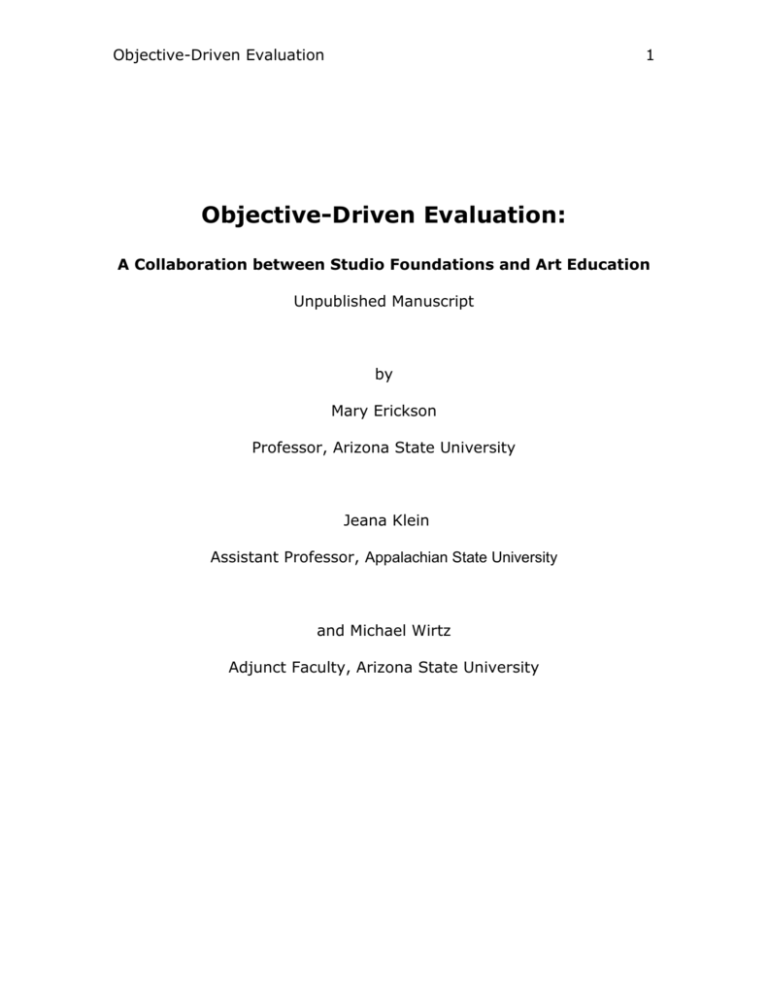Objective-driven Evaluation.
advertisement

Objective-Driven Evaluation 1 Objective-Driven Evaluation: A Collaboration between Studio Foundations and Art Education Unpublished Manuscript by Mary Erickson Professor, Arizona State University Jeana Klein Assistant Professor, Appalachian State University and Michael Wirtz Adjunct Faculty, Arizona State University Objective-Driven Evaluation 2 This is the story of a collaboration that arose from interests shared by two Master of Fine Arts students and an Art Education professor at Arizona State University. The professor was teaching art-teacher preparation classes and graduate art education research courses. The MFA students were teaching studio foundations courses. They met in a course taught be the professor for graduate students from any major in the School of Art who wanted to reflect on and improve their teaching. Master of Fine Arts students and art education researchers bring complementary concerns and perspectives to art evaluation. Although the collaborators are not ready to pronounce any one-sizefits-all solution to the challenges of evaluating student art nor do they claim that the totality of art learning is measurable, they have gained some insights to improve their own teaching practice that may be useful to others who face similar challenges. Most of the TAs who teach in Arizona State University’s Core (Studio Foundations) Program are novices. They have never studied education and may be teaching for the first time. Dan Collins, Coordinator of Arizona State University’s Core Program, meets regularly with Master of Fine Arts students who teach Two-Dimensional Design, ThreeDimensional Design, and Color courses. Core Teaching Assistants (TAs) have an evolving online curriculum resource [http://www.asu.edu/cfa/wwwcourses/art/SOACore] to help them plan their classes. As they implement their plans, they tend to draw upon their recollections of their own university art courses as models for evaluating student art. James (1996) documents traditions of university studio instruction. [In] much studio instruction, information [is] communicated largely through visual and oral models, many of the lessons [are] implicit, and students [are] generally expected to make sense of their expectations on their own. Beginning students may not know how to interpret, conceptualize, or integrate the seemingly ineffable knowledge that is constructed during studio practice (1997, pp. 86-87). Because evaluation can be a struggle for novice teachers, Collins regularly invites Mary Erickson, a member of the Art Education faculty, to speak to TAs on that subject. Since the 1970s,“accountability” has been an increasing concern for elementary and secondary art teachers. With the advent of national Objective-Driven Evaluation 3 and state visual art standards in the 1990s and the No-Child-LeftBehind legislation of 2001, pressure to demonstrate student learning in schools has been on the rise. Pressures for accountability in higher education may never match the level of public scrutiny focused on K12 instruction. Nonetheless, many TAs feel the pressure of student confusion about and dissatisfaction with how their art is evaluated as well as the pressure of their own sense of fairness as they work to develop clear and useful evaluation policies. Recognizing interests shared by all art educators regardless of the levels at which they teach, Erickson designed a graduate course focused on planning and assessing art learning in its broadest sense. Graduate students in Master of Fine Arts, Art History, and Design programs joined graduate students in Art Education to develop plans to more effectively share their art knowledge and skills with others. Jeana Klein and Mike Wirtz implemented the plans they developed in this course in their subsequent teaching of Core classes. This crossprogram graduate course provided Klein and Wirtz with experience in articulating clear, yet open-ended objectives and in using those objectives as the bases for designing evaluation guides. Their success in implementing those objectives and guidelines led Klein and Wirtz to join Erickson in further investigation and to share evaluation insights through this report. Early in their collaboration, Erickson, Klein, and Wirtz discovered that their understandings of key terms differed substantially. They wondered whether their differences were representative of other TAs at Arizona State and among undergraduates enrolled in Core courses. They developed a survey, asked 12 TAs and 35 undergraduates to choose one of three student artworks, and respond to the following: 1. 2. 3. 4. 5. 6. Describe the artist’s technique. Describe the conceptual basis of the piece. Is the piece aesthetically successful? Why or why not? Is the piece creative? Why or why not? Is the work expressive? How? Evaluate the craftsmanship of the piece. Be specific. Sure enough, both groups (TAs and undergraduate students enrolled in Core courses) used some key terms inconsistently. When considering "craftsmanship" and "technique," TAs consistently discussed materials and processes. Some expanded to speculate on the artist’s presumed intent or the style in which materials were used, Objective-Driven Evaluation 4 with descriptions such as "[the brushstrokes] seem like they were intended.” The undergraduate students, however, varied greatly in their understandings of these seemingly basic concepts. When considering craftsmanship, the majority of students failed to mention materials or processes and instead discussed aspects as varied as composition and level of realism. "Conceptual basis" and "expressive" resulted in even more varied responses from students, including the common evasion "it is open to interpretation." In response to both “conceptual basis” and “expressive,” TAs generally mentioned communication of an idea. The question involving the work’s "aesthetic success" more frequently generated comments on the formal elements from TAs, while students’ comments split between discussions of formal elements and perceived communication. TAs and students alike generally concluded that some level of originality was essential to “creativity.” Peppered among responses by both TAs and students were emphatic statements, such as "all art is creative!" and "it was created, therefore it is creative.” Most TAs interpreted such common critical art words as "craftsmanship", "technique", "expression", "aesthetics", "creativity" and "conceptual" in similar ways. Students, on the other hand, attached various meanings to these terms. The effectiveness of objective-driven evaluation depends on TAs and students sharing a common language of art as it applies to grading and critiques. Establishing Flexible, Objective-Driven Evaluation Guides Instructors have a variety of worthwhile course objectives, including presenting content, establishing a stimulating and safe studio, and proper management of tools and equipment. However, objectivedriven evaluation requires a particular kind of objective, sometimes called a student learning objective. Such an objective is a statement by the instructor that identifies what a student should be able to do through completing an assignment. An evaluation guide distinguishes differences in student learning outcomes, that is, what students show in their completed assignments that they can actually do. Student learning objectives are useful both in planning assignments and in evaluating student art made in response to assignments. After designing objective-driven evaluation guides, Wirtz and Klein discovered they could clarify expectations while maintaining flexibility. They found that carefully articulated objectives stated as complete Objective-Driven Evaluation 5 sentences leave less room for misunderstanding than single terms or short phrases, such as “solution to problem,” “creativity,” “craftsmanship,” or “technique.” Such objectives provide a basis for establishing distinct levels of student achievement. Multi-level evaluation guides allow instructors to evaluate each student’s assignment based on how well that student satisfied each of the objectives. Wirtz identified the three following general student learning objectives and then developed three-level guides to evaluate student work (outcomes) for each objective: 1. Student applies foundation principle/s effectively (for example, mass, unity, line quality, subtractive color mixing, figure-ground, etc.) Exceptional = The assignment demonstrates the student’s clear understanding of the chapter or unit principle. Competent = The assignment demonstrates the student’s partial understanding of the principle. Unsuccessful = The assignment demonstrates no understanding of the principle. 2. Student uses assigned tools, materials, and techniques well. Exceptional = The assignment is highly crafted and demonstrates the use of proper techniques. Competent = The assignment has some blemishes that result from the slight misuse of the materials or techniques. Unsuccessful = The assignment demonstrates little or no attention paid to craft, materials, or technique. 3. Student demonstrates innovative solutions to the assigned problem. Exceptional = The assignment demonstrates that the student looked for a better solution to the problem rather than relying on the most basic (obvious, common, usual, predictable, etc.) solution. Competent = The assignment does not show much innovation or exploration beyond the most basic (obvious, common, usual, predictable, etc.) solution to the problem. Unsuccessful = The assignment demonstrates a basic (obvious, common, usual, predictable, etc.) solution. Objective-Driven Evaluation 6 Wirtz links his evaluation guides to grading by assigning points to each level of achievement of each objective. He varies the weighting of points assigned to each general objective to match the importance of that objective in specific assignments. One assignment might place more emphasis of formal principles than on innovation, in which case Wirtz assigns more points to objective #1 than to objective #3. Wirtz found the general objectives to be convenient starting points that are adaptable to specific assignments. For example, in a twodimensional design assignment given as part of a unit on compositional devices, he asked students to create a compositionally balanced protest poster. Although the protest topic was left up to the individual student, he required that the topic meet a pre-discussed definition of protest: communication that runs contrary to the top down flow of information. Wirtz identified three specific objectives and developed multi-level evaluation guides for each. The objectives were: 1. Student applies the principle of compositional balance. (Wirtz believes that a project can usually be considered either balanced or not balanced compositionally, therefore, he eliminated the competent level in his evaluation guide.) Successful = Student constructs a poster that is balanced compositionally. Unsuccessful = Student constructs a poster that is not balanced compositionally. 2. Student uses cut paper and associated materials successfully. Exceptional = Assignment is highly crafted with few (no more than two) small blemishes (for example, small spots of glue on the surface of the paper, or slightly frayed paper edges caused by a dull knife). Competent = Assignment displays several blemishes consistent with the slight misuse of the paper and glue (for example, larger spots or smudges of glue and frayed or torn paper edges). Unsuccessful = Assignment displays minimal consideration for craft (for example, ripped paper edges caused by careless tearing or improper use of cutting tools, large smears or stains caused by using too much glue, and surface marks caused by dirt and other debris). 3. Student chooses a protest topic and communicates that topic through a visual medium. Objective-Driven Evaluation 7 Exceptional = The protest poster meets the definition of protest and clearly communicates the desired topic. Competent = The protest poster meets the definition of protest but does not clearly communicate the desired topic. Unsuccessful = The protest poster does not meet the definition of protest or fails to communicate any idea of the desired topic. Wirtz found objective-driven evaluation to be useful in clarifying general course objectives, yet flexible enough to adapt to the peculiarities of specific assignments. Reflections on the Value of Writing Objectives Klein’s experience using evaluation guides based on objectives has significantly transformed her approach to grading student art. She concludes that although the idea of formalized objectives and evaluations is loathsome to many artists, the benefits are numerous to instructor and student alike. For the instructor, the act of identifying and verbalizing specific objectives and their associated evaluation guides serves to organize the course, ease the challenges of grading, and assess the overall effectiveness of the course. For the introductory art student, clearly stated objectives and evaluation guides help in attaining goals and learning from feedback. As a TA, Klein’s understanding of objectives and evaluation has been evolving over three years. Initially, she provided vague objectives on syllabi and orally evaluated assignments, but consistently secondguessed her own ability to objectively evaluate student artwork. She has steadily increased the specificity of assignments and expectations and now feels she can quite confidently state precisely what the objectives of any given assignment may be and can specify grades for various outcomes. The unexpected bonus of established objectives and evaluation guides for Klein has been a sharp reduction in grading time. When she has determined in advance what constitutes an A, B, C or D for each objective, she does not waste time questioning whether she is actually favoring craftsmanship over composition or an outgoing student over a shy student. She can see, quite simply, whether a project has implemented the unit’s lesson in a successful manner. Objective-Driven Evaluation 8 By verbalizing objectives and evaluating the projects, she is able to assess the effectiveness of her instruction. If a unit’s objective is completely unrelated to the assigned project, the results are generally disappointing. With formal objectives and evaluation guides, it is much easier to determine where the problem lies. If the majority of projects are flawlessly crafted and soundly composed, but completely lacking in conceptual thought, then perhaps the unit’s conceptual (formal principle) objective was not clearly stated or not present in the assignment. If students consistently create meaningful, well-composed compositions with poor craftsmanship, she may need to more thoroughly demonstrate the uses of the tools, materials, and techniques. Klein concludes that specific objectives and their evaluation guides need not be excessively rigid. On numerous occasions, a student’s performance in one area, perhaps involving a new technique beyond those taught in class, is so outstanding as to partially counteract deficiencies in other realms, such as less-than-perfect craft or a hazy concept. With objectives and evaluation guides firmly in place, grading flexibility lies in the hands of the instructor. Therefore, students are much less likely to independently initiate bargaining for grades. For the beginning art student, articulated objectives and evaluation guides are perhaps even more important. Depending on the program, many beginning art students have had very little, if any, formal art education. Many students arrive at college without knowledge of basic art vocabulary or any understanding of the purpose of foundation art courses. Many perceive art-making as a mystical process that can only be properly undertaken by those born with talent. They also may assume that all art is inherently good, and therefore beyond the realm of grades. Objectives broken down into specific, attainable pieces help students examine both their own artworks and those of their peers more clearly and rationally. When the evaluation is clearly based on the art produced -- rather than the assumed, perceived, or imagined talent of the student producing it -- critical feedback can be more productively given and taken. Students can evaluate their own artworks in advance in relation to defined objectives, and are therefore ultimately responsible for their own grades. When armed with well-reasoned objectives and evaluation guides, students know what is expected of them. They can identify achievable goals. They can begin working immediately and spend less time Objective-Driven Evaluation 9 floundering about searching for a solution to the assignment. They are discouraged from making excuses. They are able to overcome many of the prevailing myths about the impossibility of actually judging art. Finally, students presented with articulated objectives and evaluation guides learn to be articulate from that example. With art vocabulary defined and a framework for evaluation established, students are able to productively participate in critiques. They develop more constructively critical eyes and the ability to form concrete verbal evaluations. Conclusions and Issues for Further Collaborative Reflection As goals of foundations art courses evolve, written language can be brought into service to negotiate conclusions about the meaning and value of student art. Wolcott and Gough-Dijulio (1997) propose that even in art, “concepts become more manageable when we can name them” (p. 147). Eubanks (2003) describes “artistic codeswitching” as the interaction of visual and verbal codes. She writes: ...the artist/critic puts aside the artist/creator’s intentions and looks at the work with fresh eyes. .... When the artist/creator takes the position of the artist/critic for the sake of conscious examination of the artistic product, the artist/creator can then take that information and use it to analyze and verify meaning in the art, thereby completing the creative process (p. 14). As the collaborators in this report have suggested, verbalization can be a tool not only to help foundations art teachers clarify their expectations, but also for beginning art students to improve their work. Although the traditions, constraints, and expectations for artwork vary substantially from elementary and secondary programs to university studio foundations, a significant number of concerns are shared. In this collaboration, teachers of both studio foundations courses and traditional art education courses refined their understandings of the role objectives can play in evaluating student work. The authors of this report hope to encourage other art faculty and TAs to break traditional program barriers in search of the rewards and stimulating dialogue of collaboration. Objective-Driven Evaluation 10 References Eubanks, P. (2003). Codeswitching: Using language as a tool for clearer meaning in art. Art Education, 56(2). 13-18. James, P. (1996). The construction of learning and teaching in a sculpture studio class. Studies in Art Education, 37(3), 145-159. James, P. (1997). Learning artistic creativity: A case study. Studies in Art Education, 39 (1), 74-88. Wolcott, A. G. & Gough-Dijulio, B. (1997). Just looking or talking back? A postmodern approach to art education. In J. W. Hutchens & M. S. Suggs (Eds.) Art Education: Content and practice in a postmodern era, (pp. 143-153). Reston, VA: National Art Education Association.






